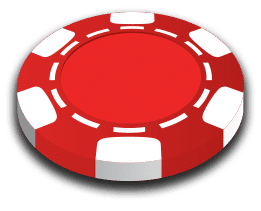The late Mike Sexton introduced the popular World Poker Tour television show with the following words:
“The name of the game is no-limit Texas hold’em; the game that takes a minute to learn, but a lifetime to master.”
If you have never played this great game before, but are interested in doing so, this article is for you. It will take a little longer than a minute to learn, but in what follows we describe the rules and procedures of no-limit hold’em to a level that will get you started.
Does it really take a lifetime to master hold’em? It is arguable that nobody has fully grasped all the intricacies of this game. However, if you are intrigued by the introduction provided here, we can tell you that our CORE program can take you from a rank beginner to the best player in your home game in a matter of weeks.
While pots can be won in no-limit hold’em without having the best hand, we still need to know what beats what. The next section looks at the ranking of hands in no-limit hold’em.
The Rank Of Hands In Texas Hold’em Poker
Most forms of poker share a common list of hand rankings. As we just noted, some poker hands are won simply because all but one player chooses to “fold.” When this is not the case, the winner is determined by who has the strongest hand according to the list below.
In no-limit hold’em specifically, we are always looking to make our best five-card hand from the seven total cards that are available to us: the five “board” or “community” cards dealt in the center of the table, and our two hole cards. We can use both our hole cards, one of them, or simply “play the board” if the five community cards gives us our strongest hand. We’ll give some additional examples of such hands once we’ve described the rank of hands.
Straight flush
The highest hand in hold’em is the straight flush. It consists of five cards all of the same suit that are consecutive in rank. For example:
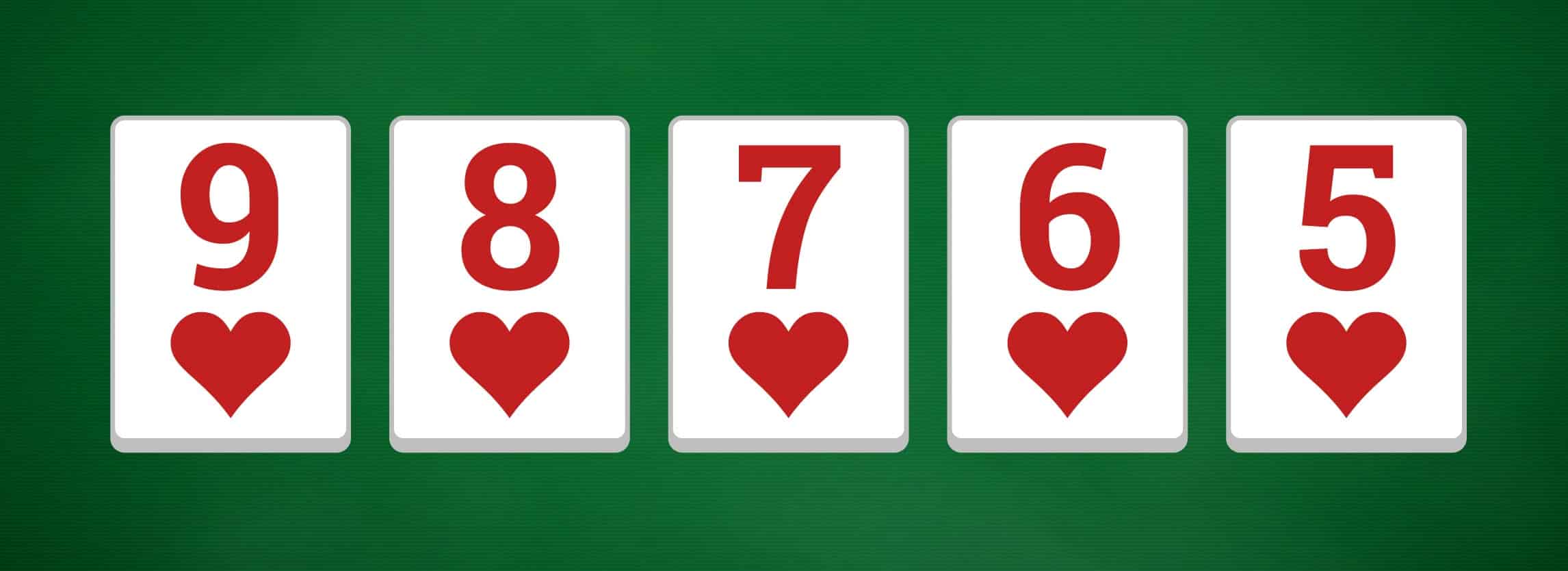
is a straight flush.
The grand-daddy of all hold’em hands is the highest possible straight flush, known as a royal flush:
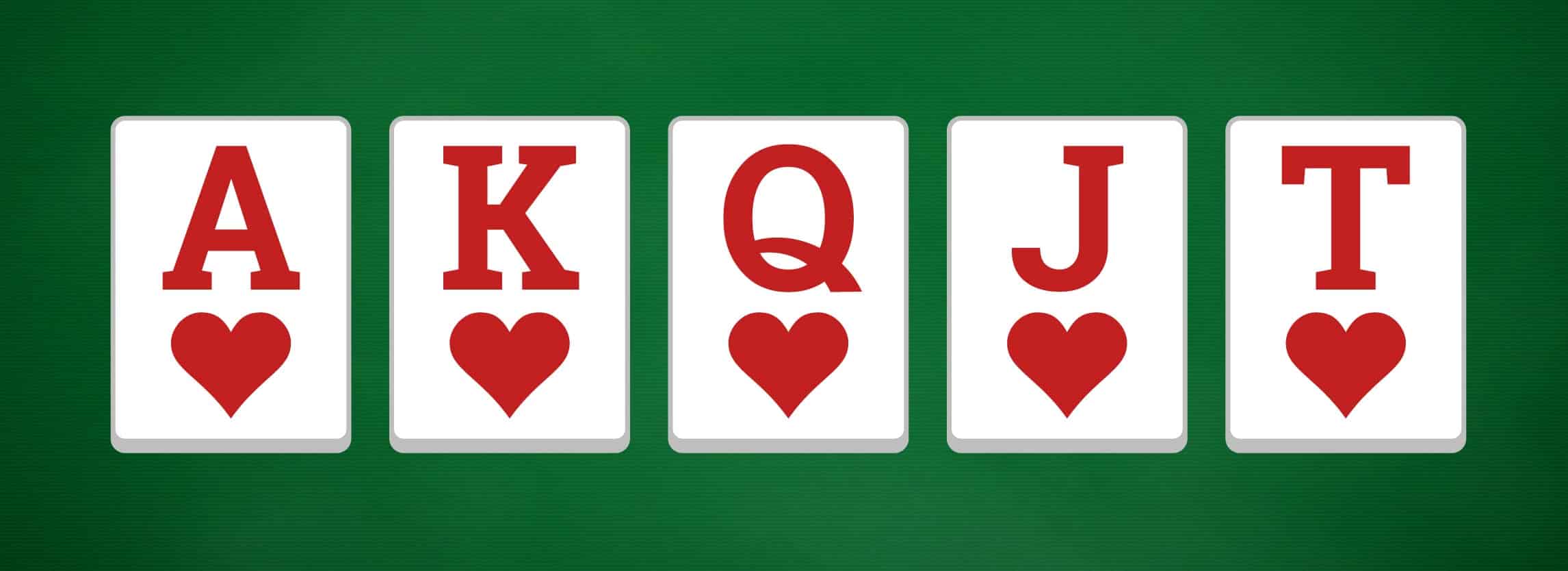
If two players both hold a straight flush, the winner is determined by the rank of the highest card. Thus the royal flush beats all other straight flushes.
Note that unlike some card games such as bridge, the suit of flushes and straight flushes does not matter in hold’em; that is, a royal flush in spades has the same value as a royal flush in hearts.
Four of a kind
Also known as “quads,” this hand is comprised of four cards of the same rank. For example:
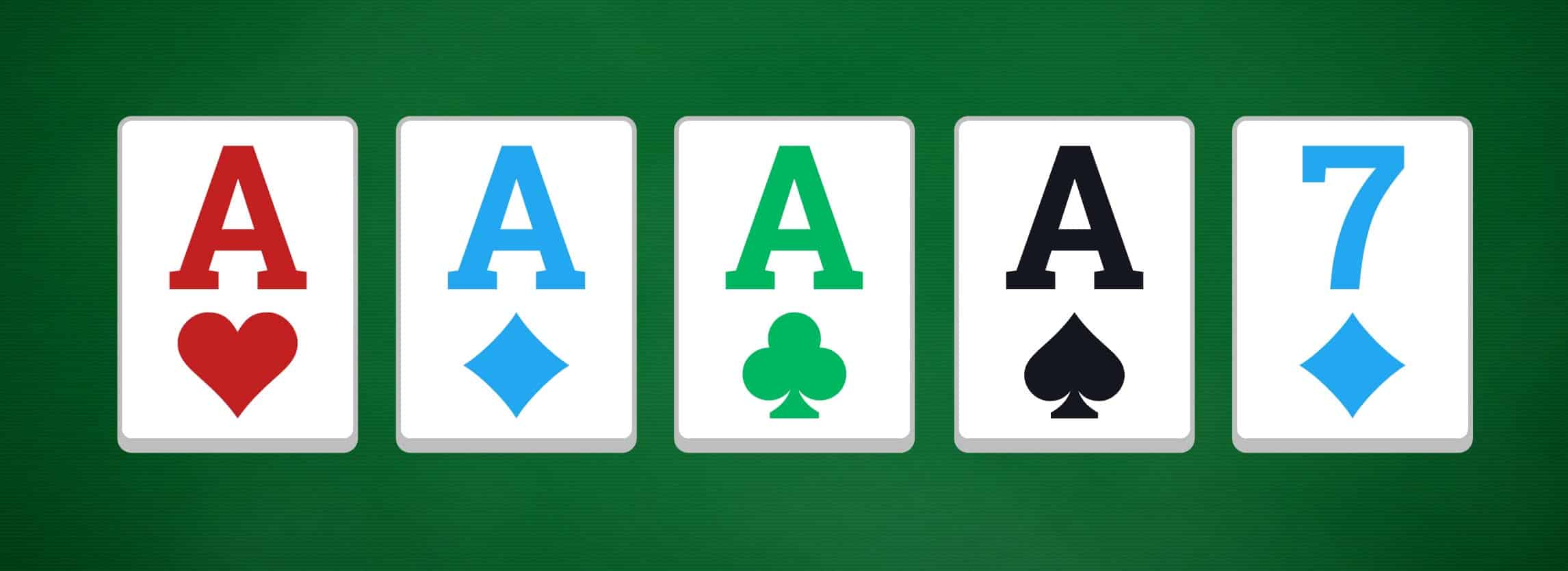
is four or quad aces, and is the highest possible four-of-a-kind hand in no-limit hold’em. The rank of quads follows the standard rank of cards, so that quad kings is higher than quad queens, and so on.
Full house
The full house is a combination of three of a kind and a pair. For example:
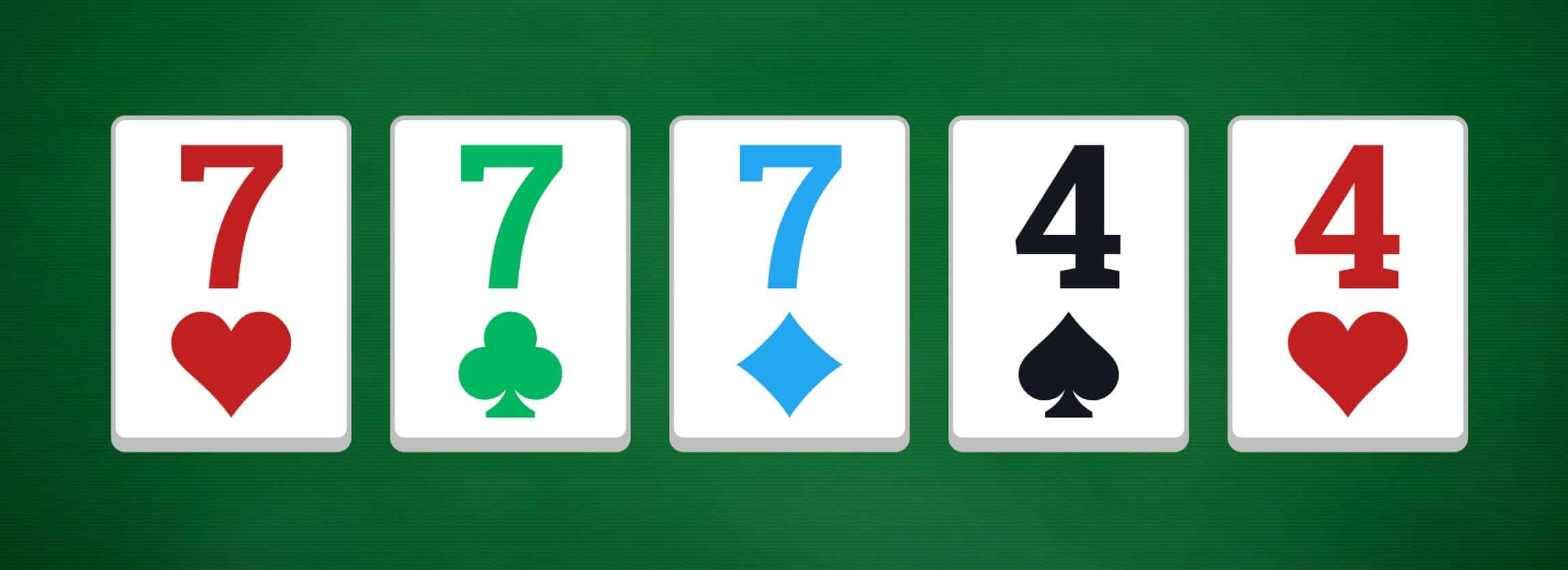
This oddly-named hand may have received its moniker by virtue of being the first full five-card hand, prior to the introduction of the straight flush. It’s also called a “full boat” or simply “boat,” perhaps reflecting the fact that poker in the U.S. was initially played extensively on riverboats. Plus if you use your imagination and squint, two cards on top of three others looks a bit like a boat. The hand shown above is read as “sevens full of fours,” or simply “sevens full.”
The hand sometimes causes confusion with beginners, particularly when two full houses are made. The point to remember is that it is the three-of-a-kind portion of the hand that determines its rank. Thus the 77744 shown above would beat 555AA, but lose to QQQ22.
Flush
The flush is comprised of five cards of the same suit, but not consecutive in rank since that would form a straight flush. For example:
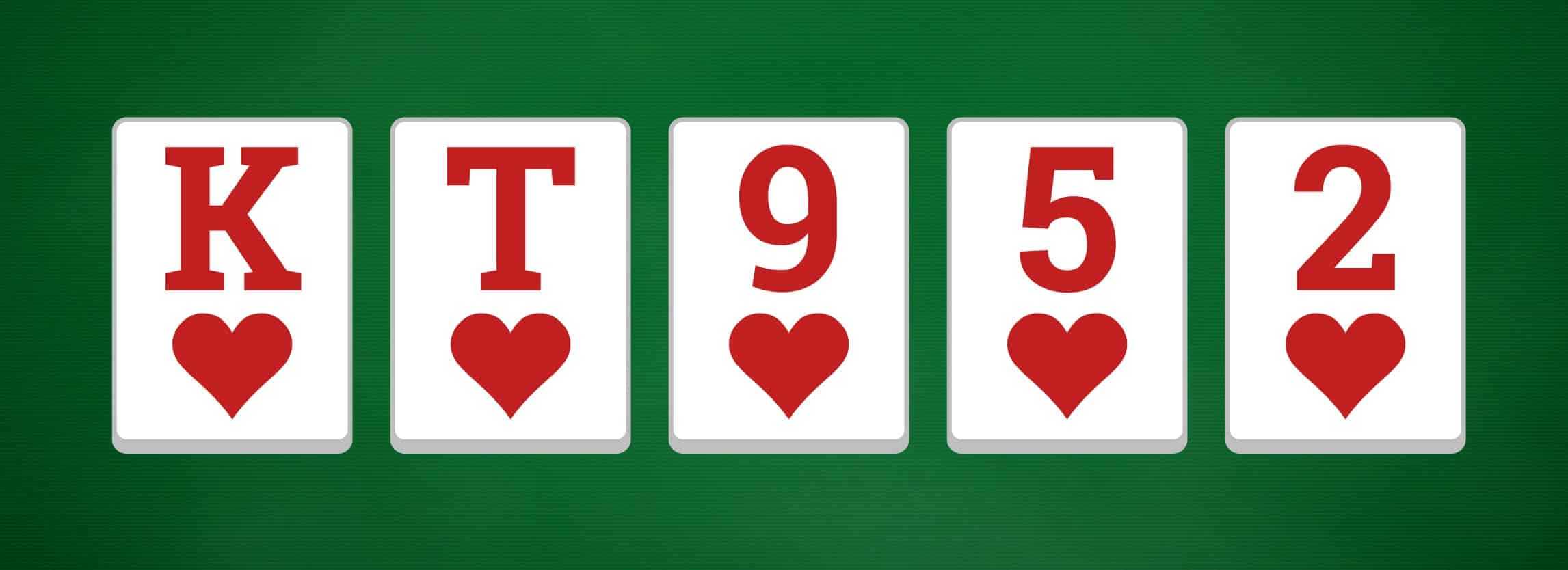
When two flushes are made, the one with the highest top card wins. For example, suppose the final board (the five community cards: see the following section) is 9♥5♥2♥A♦6♦. One player holds the hole cards K♥T♥, whereas their opponent has the Q♥J♥. The player with the K♥T♥ wins the hand. In fact, their winning hand is precisely the one shown in the image above.
It takes a little experience to recognize what the best hand is. For this reason, we provide more examples at the end of the article, along with a quiz.
Straight
A straight is any five-card hand in which the cards are in consecutive rank, but not all of the same suit. For example:
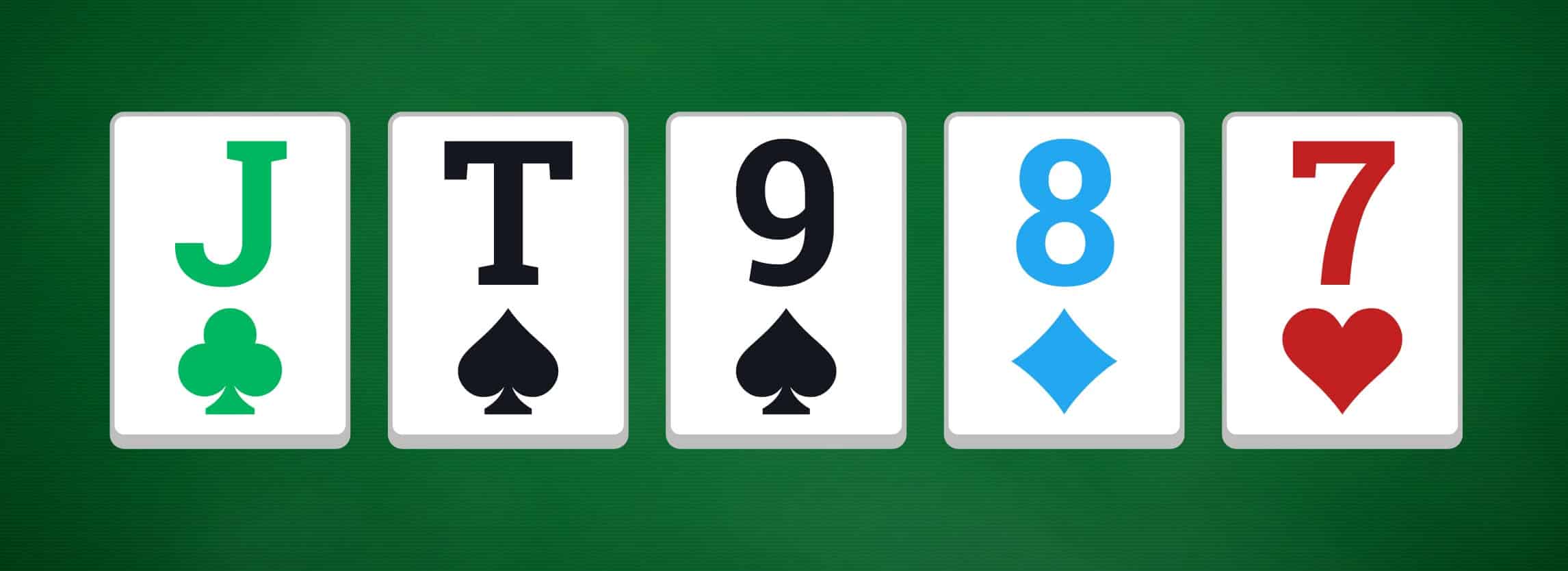
As with the other hands already discussed, the highest card determines which straight wins when two are made. Thus the hand in the image would beat any straight with a top card T or lower, but lose to any straight headed by a Q, K or A. The highest possible straight is the AKQJT, and is referred to by various names including “broadway” and “treetop.”
Three of a kind
As the name suggests, this hand is made from three cards of the same rank. For example:
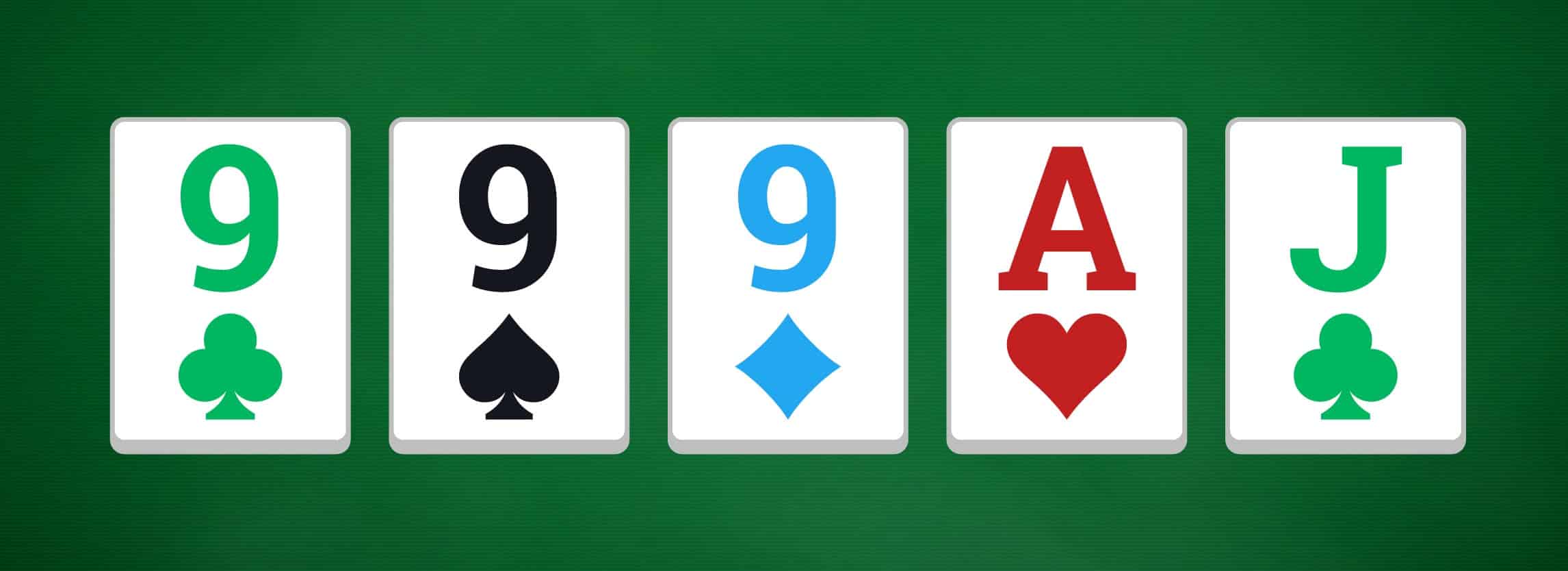
This being poker, however, the story doesn’t end there. If you hold a “pair in the hole” (your hole cards are of the same rank) and a third card of that rank appears on the board, you are said to have a “set.” However, if there is a pair on board and one of your hole cards is of the same rank, you hold “trips.”
In the latter case, it is possible for two players to hold the same trips. Who wins then? Consider the following scenario:
Kim’s hole cards are the A♠K♦, while her opponent Jason holds A♣Q♥. The final board is 2♣5♦A♦A♥J♣. Both players have trip aces. To decide who wins, we look at the best five-card hand that each player can make using their hole cards and those on the board.
Kim’s hand is: A♠A♦A♥K♦J♣
Jason’s hand is: A♣A♦A♥Q♥J♣
Since both players have trip aces, we go to the next highest card to determine a winner. In this case, Kim’s K♦ is higher than Jason’s Q♣, so Kim wins the hand.
Two pair
Two pair is comprised of two cards of the same rank (the first pair), along with another two cards of the same rank that differ in rank from the first pair (the second pair). For example:
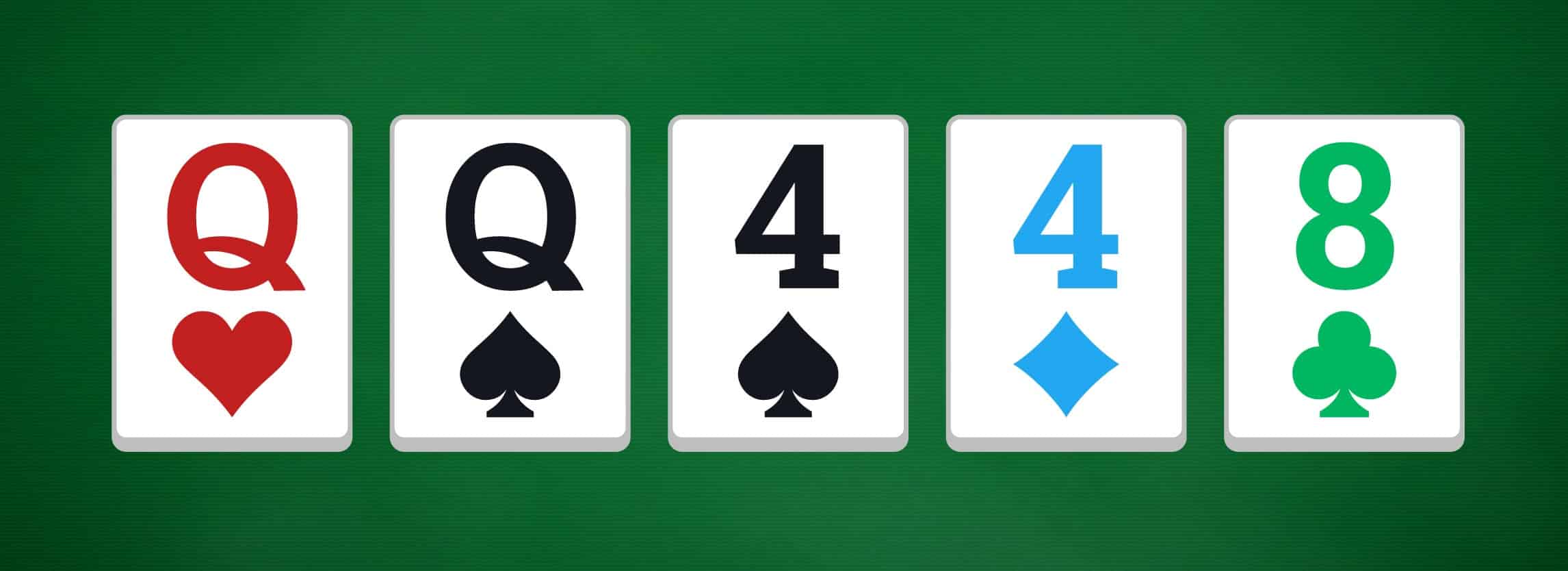
Like the full house, it is the higher pair that determines the winning hand. Thus AA44 beats KKJJ. The two-pair hand shown in the image above is sometimes called either “queens and fours” or “queens up.”
Pair
A pair is simply two cards of the same rank, with no other hand value given by the various categories listed above. For example:
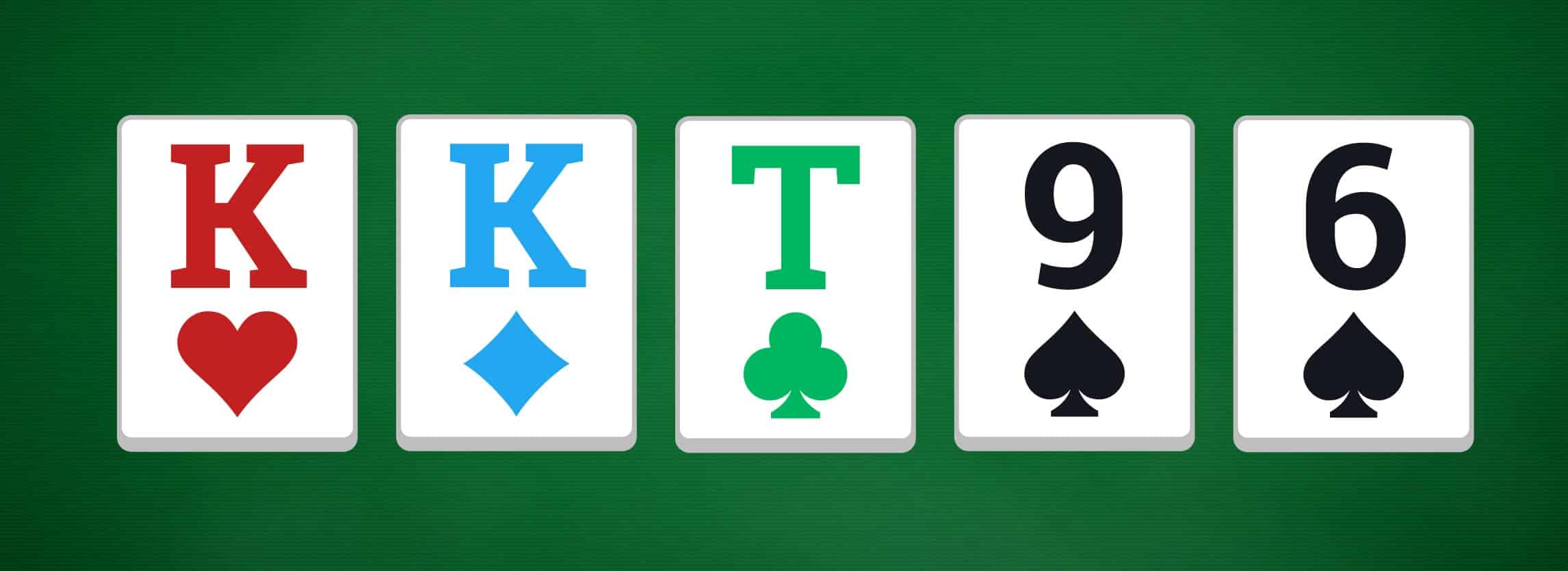
is a pair of kings. When two players both have a pair, the winner is determined in the normal way by the rank of the paired cards. Thus AA beats every other one-pair hand.
High card
If none of the above-named hands can be made by any player, the best hand is determined by high card. For example:
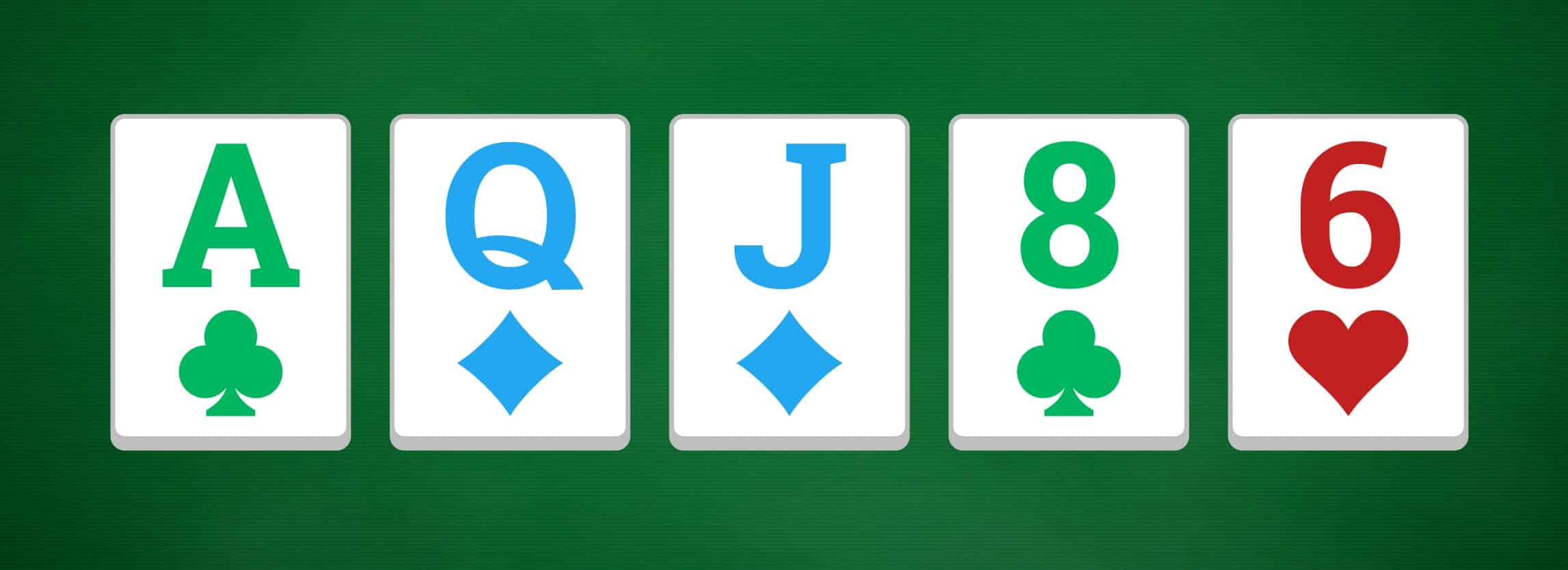
is an A-high, and would beat any hand not featuring an ace. If more than one player has A-high, the next highest card is used to determine the winner.
This hand-strength list does more than tell us “what beats what.” It also informs our decisions of whether to check, bet, call or raise when we are playing a real hand of no-limit hold’em. To understand how that works in practice, let’s turn to the mechanics of playing a hand of hold’em.
Rules And Game Play Of No-Limit Texas Hold’em
No-limit hold’em can be played between as few as two players, with six to nine players being more common. For simplicity, we will focus on a 6-handed game, which is the most popular format in online poker.
In what follows, we’ll begin with a summary of how a hold’em hand is dealt. If you’ve watched poker on television or stream, this will likely be familiar to you. However, the main complexity of all forms of poker is the betting. Once we’ve provided an outline of the action, we’ll return to the details of how betting works.
In a home game played among friends, it is usual for each player to deal a hand, then pass the deck to the player on their left who repeats the process. In a casino or an online game, the deal also rotates clockwise. To keep track of the notional dealer, a disk called the “button” is used. This is shown as the disk with “D” on it in the schematic below.
The player with the dealer button in front of them is often referred to as “the button.” In the image below, this is abbreviated to “BTN.”
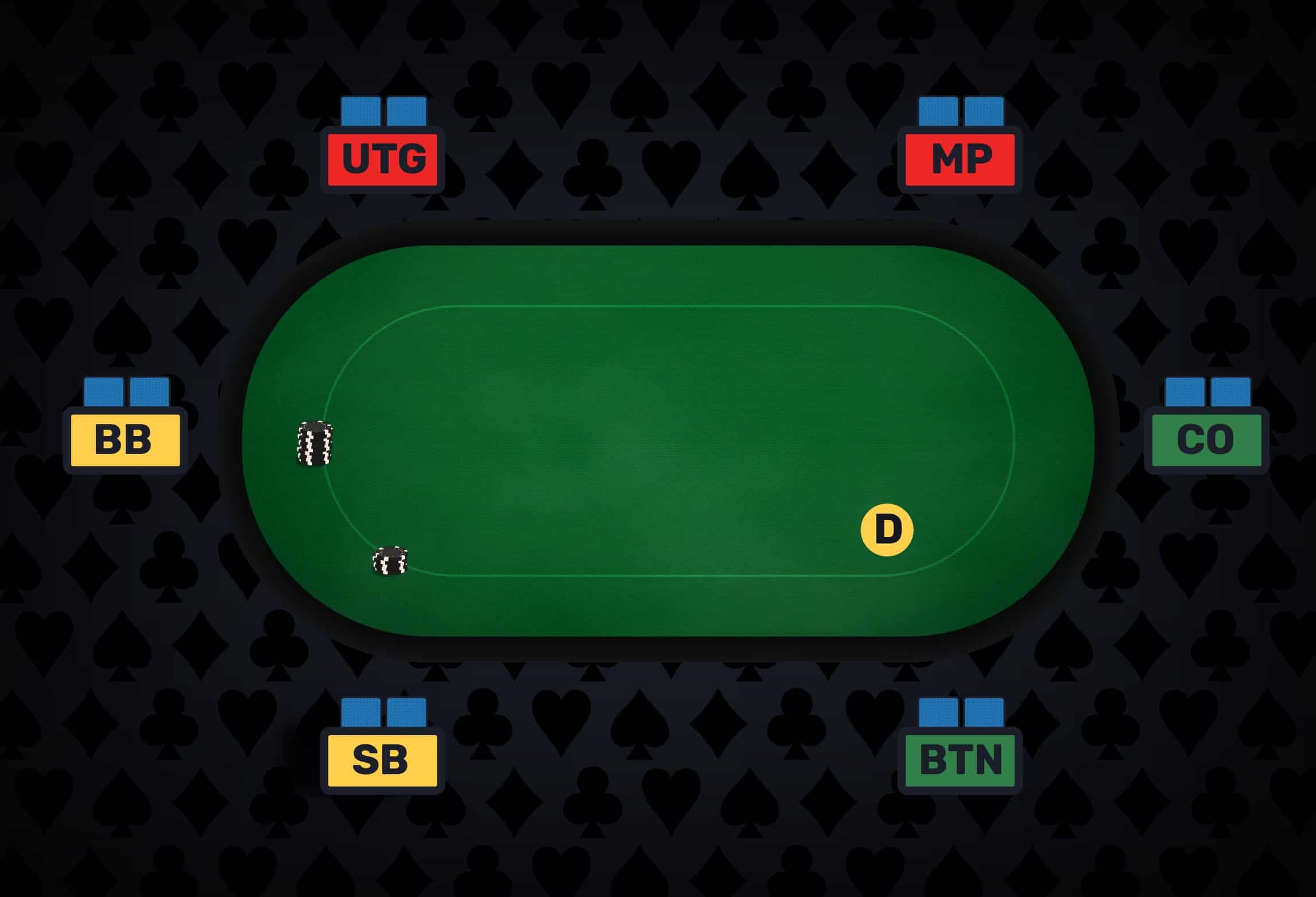
The two players to the left of the button are called the small blind (SB) and big blind (BB). These players must post “blind” bets before any cards are dealt. In many instances, the big blind is twice the small blind. For example, in the lowest-stakes played in Las Vegas casinos, the small blind posts $1 and the big blind posts $2.
These blinds serve a similar function to the antes used in many home games. They put some initial money in the pot. In essence, the game is driven by the players contesting that initial money, along with any other bets that go into the pot.
Preflop
Once the blinds have been posted, each player receives two cards dealt face down. These are their “hole cards.” The player to the immediate left of the BB (often called the “under-the-gun” player or UTG) is first to decide whether they fold, call, or raise the blind bet posted by the BB.
Folding means they discard their hand and sit out until the next deal. Calling means matching the big blind, so that if the blinds are $1 and $2, a call requires the player to put $2 into the pot. A raise can be any amount from $4 to the famous “all in” in which a player commits all their chips. Anyone wishing to remain in the hand must call all bets and raises. In other words, the remaining players must all contribute the same dollar amount to the pot.
Once the betting action is complete (more on this below), the preflop action is concluded and the flop is dealt.
The Flop
The flop consists of three community cards placed face up on the table, as shown in the following image.
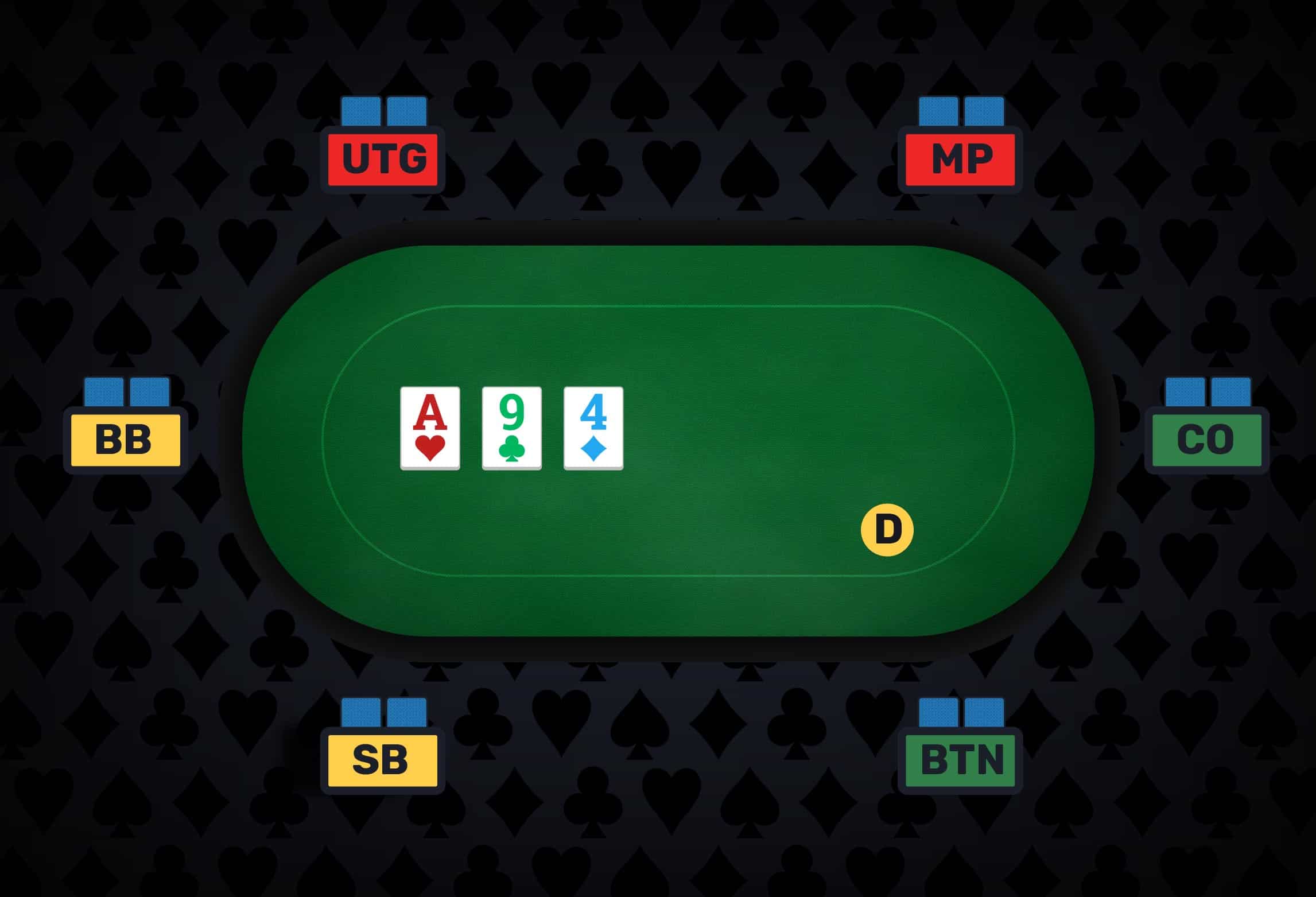
At this stage in a 6-handed game, there may be anywhere from two to six players still contesting the pot. (The players who folded preflop are now wishing the remaining players would hurry up.) The first person to act on the flop is the one closest to the left of the dealer button. For example, if both the blinds (SB and BB) folded preflop, but the UTG player still has cards (a live hand), it is the UTG player who “acts first.” They can check (bet nothing), or bet.
The action then moves clockwise to the next player still in the hand. If UTG checked, the next live player also has the option to check or bet. If UTG bets, however, the next player may either fold, call (match the bet) or raise, in a similar fashion to the preflop action. If other players are still in the hand, they are faced with the same choices. Once all bets have been called and the flop action is complete, we move to the turn.
The Turn
The turn sees a fourth card being added to the board, as shown below.
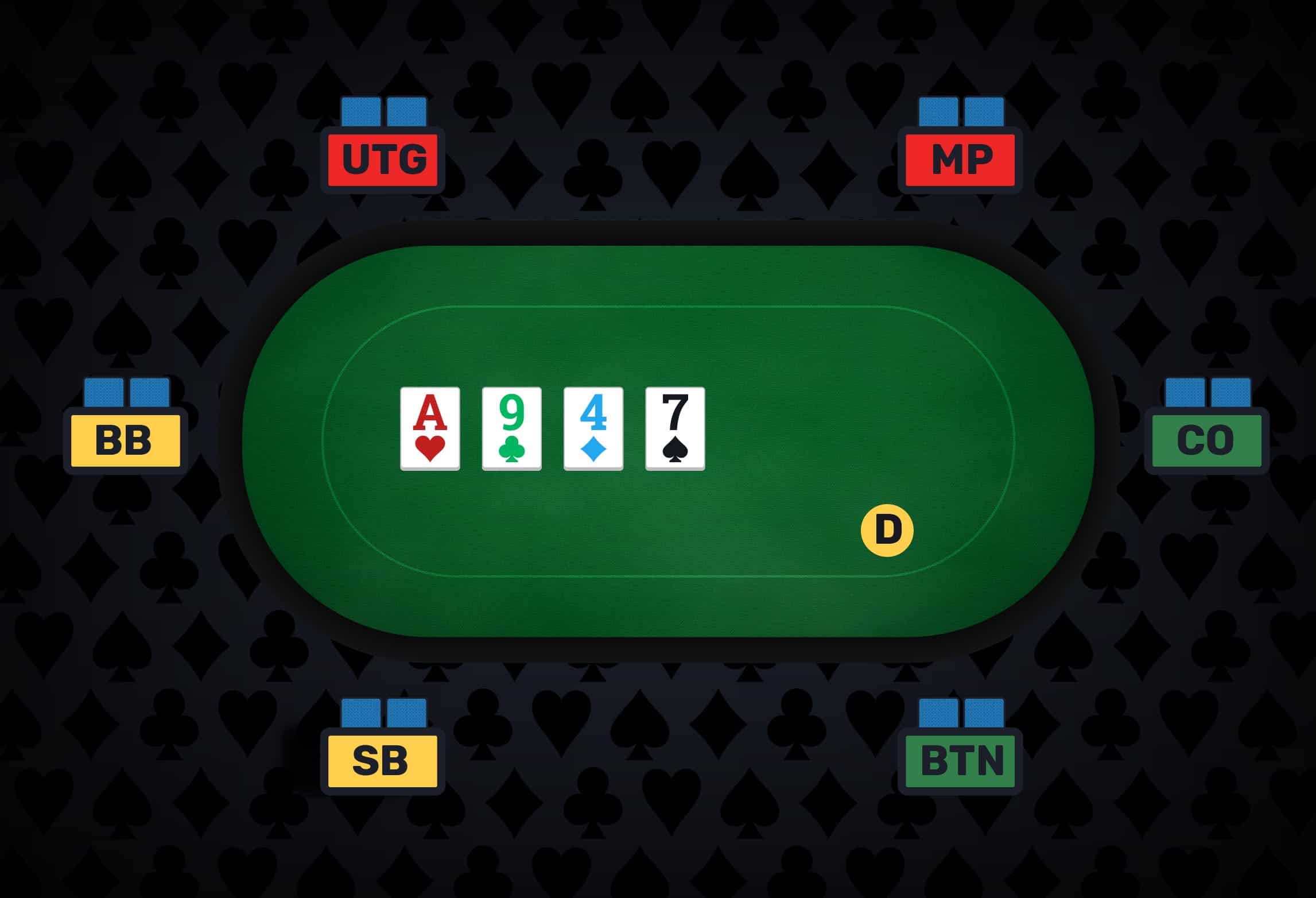
The betting action follows the same procedure as on the flop for all surviving players. Note that at any stage in the hand, if a player bets and everyone else folds, the bettor wins the pot. Assuming that there is more than one player still in the hand once the turn action is complete, we move to the river.
The River
The fifth and last community card is dealt on the river, as shown.
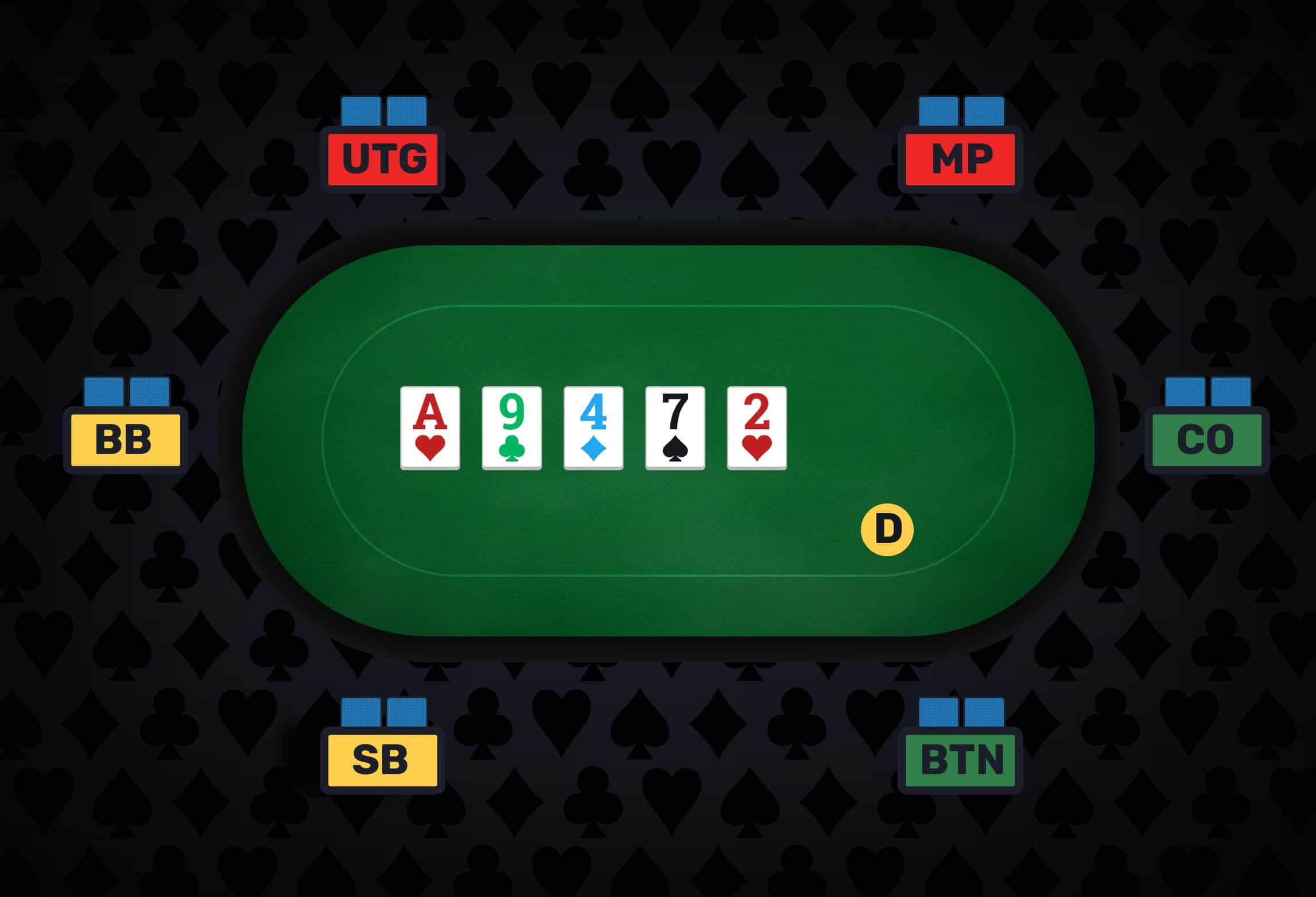
Betting again starts with the first remaining player to the left of the dealer button. As on the flop and turn, it is possible for everyone in the hand simply to check. In that case, all surviving players reveal their hole cards and the winner is decided using the rank of hands given above. This is called the showdown.
If, on the other hand, a player bets, the other remaining players have the usual choice of folding, calling or raising. Once all bets and raises have been called, the players who have not folded reveal their cards. As in the previous case, this is called a showdown, with the winner of the pot being determined by the rank of hands.
No-limit betting
In the hand walkthrough above, we outlined the rudiments of betting in no-limit hold’em. However, old Western movies in particular have created a common misunderstanding about what no-limit betting really is.
Imagine the scene. Two grizzled cowboys squint over the cards they hold in front of their faces. (Never do this, by the way. Your cards should remain face down on the table except when you squeeze up the corners to see what you hold.) One pushes forward all the chips and bills in front of him and stares down his opponent.
The second cowboy now pulls from his pocket the deeds to the family ranch. “I raise you everything I own,” he snarls, tossing the papers over the chips and bills.
Apart from being a rather impractical method of doing business, this is not what “no-limit” betting is about at all. You cannot push someone out of a pot simply because your ranch and/or livestock are worth more than theirs. In reality, no-limit hold’em is played “table stakes.” The amount of chips in front of you on the table at the start of the hand is the maximum you can wager. You cannot go “back to your pocket” to bet more. Further, if you have a total of $200, and your opponent has $150, then if the action gets all in at any stage, you only commit $150 each. Your extra $50 is never put in play.
In addition to this Hollywood-driven misunderstanding, we have also found that many new players get flummoxed by the details of the betting procedure outlined in the previous section.
One central rule that may help is that the action is complete on any street once everyone has paid the same amount. Unfortunately, this key rule has an exception preflop.
Let’s return to our six-handed table. Suppose that preflop, one or more players just call the blind bet. (This is sometimes referred to as limping.) Maybe the entire table in a $1/$2 game throws out the two bucks to create a family pot. The small blind “completes” by adding $1 to the $1 they posted before cards were dealt, and the action is now on the BB.
“But wait,” you say. “Everyone has paid the same. Don’t we just move to the flop?”
No. Poker could work like that, but by rule it does not. If nobody raises preflop, the BB has an option. (In a casino when this situation arises, a dealer may say to the player in the BB: “your option.”) The BB can either check their option, or they can raise. If they raise, anyone wishing to stay in the hand must call that raise.
When does this raising end? Can we just keep raising back and forth until all the chips are in the middle? In principle, yes. In practice, particularly among more experienced players, the two most common preflop scenarios are a “raise and take it” and a “big blind defense.” In the former, the first player who does not fold decides to raise, and everyone left folds. In the latter, a player raises, the BB calls, and the action moves to the flop as described above.
But because all players have the option to raise, the possible sequence of different actions in any poker hand are immense. If you get confused, the dealer or home-game host is there to help. Never be afraid to ask for clarification, even if you’re playing for penny stakes. Asking the right questions constitutes the bulk of learning.
And talking of questions, let’s wind up with three more.
Who wins this no-limit hold’em hand?
Particularly for inexperienced players, it can sometimes be difficult to determine who has won the hand. It’s also important to get practice with melding your two hole cards with the five community cards to figure out your best possible hand. We now give some examples of determining who has won a no-limit hold’em poker hand to help you with this process.
Hand #1
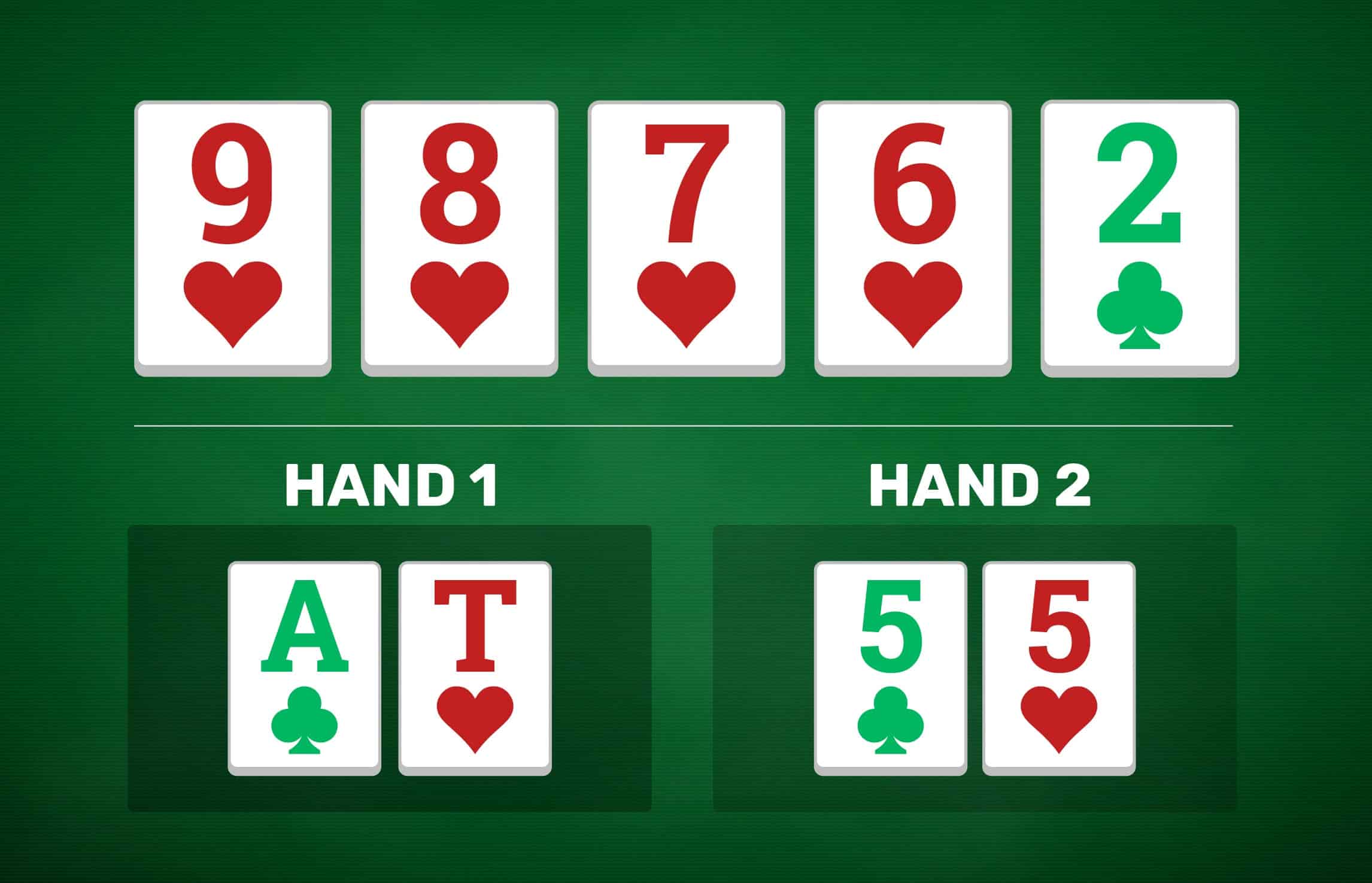
This first example is admittedly unusual, but if you play poker long enough you’ll see some pretty weird hands. By the end of the action, both players have made straight flushes! Hand 1 is a straight flush to the T, whereas Hand 2 is a straight flush to the 9. Hence Hand 1 is the winner.
Hand #2
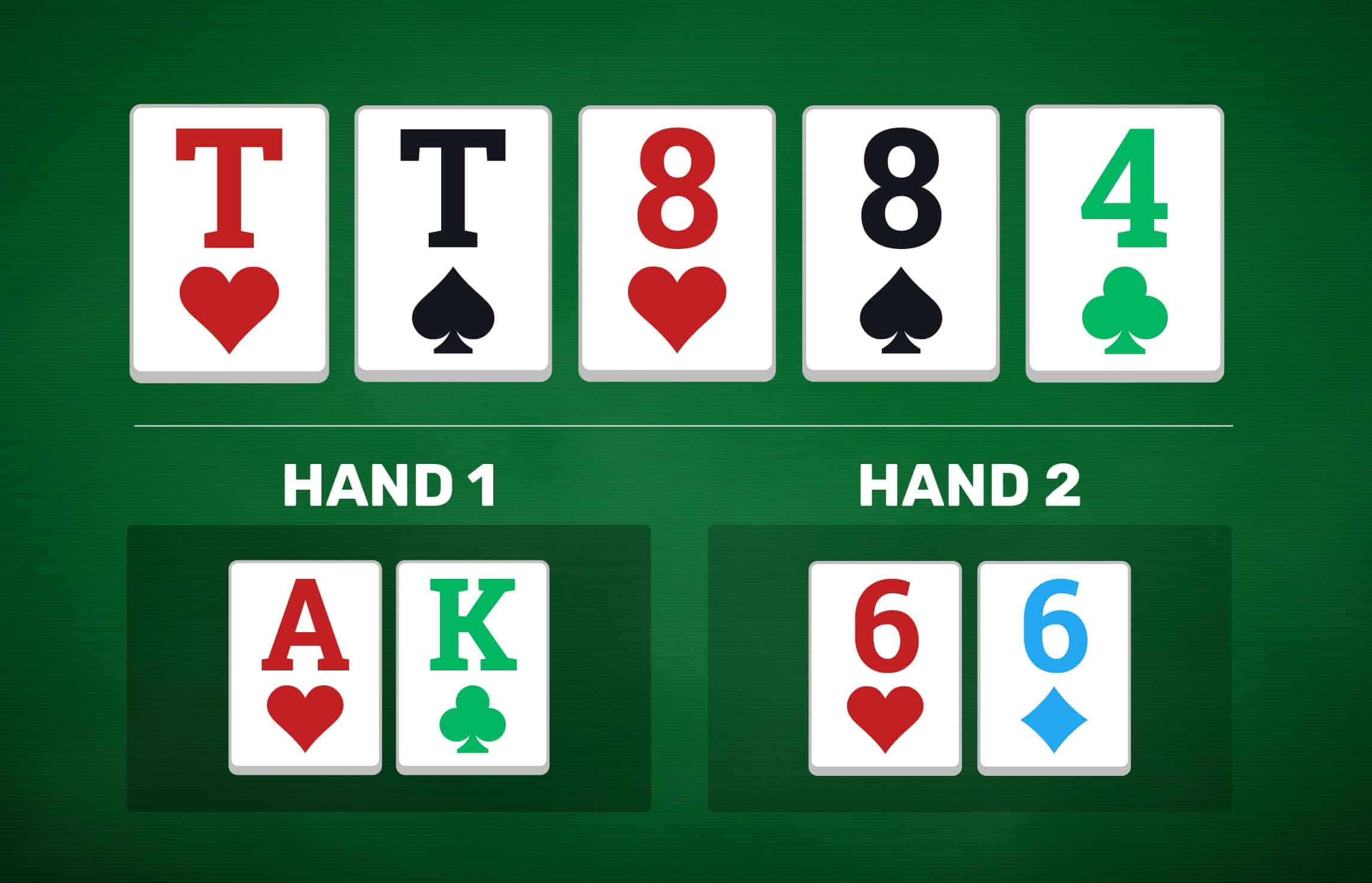
A situation where the board features two pair often creates confusion. Recall that there is no “three pair” in hold’em. Thus the best hand that Hand 2 can make is TT886, using the 6 from their hole cards as a “kicker.” Hand 1, in contrast, can make TT88A. Hand 1’s ace is higher than Hand 2’s six, thus Hand 1 is the winner.
Hand #3
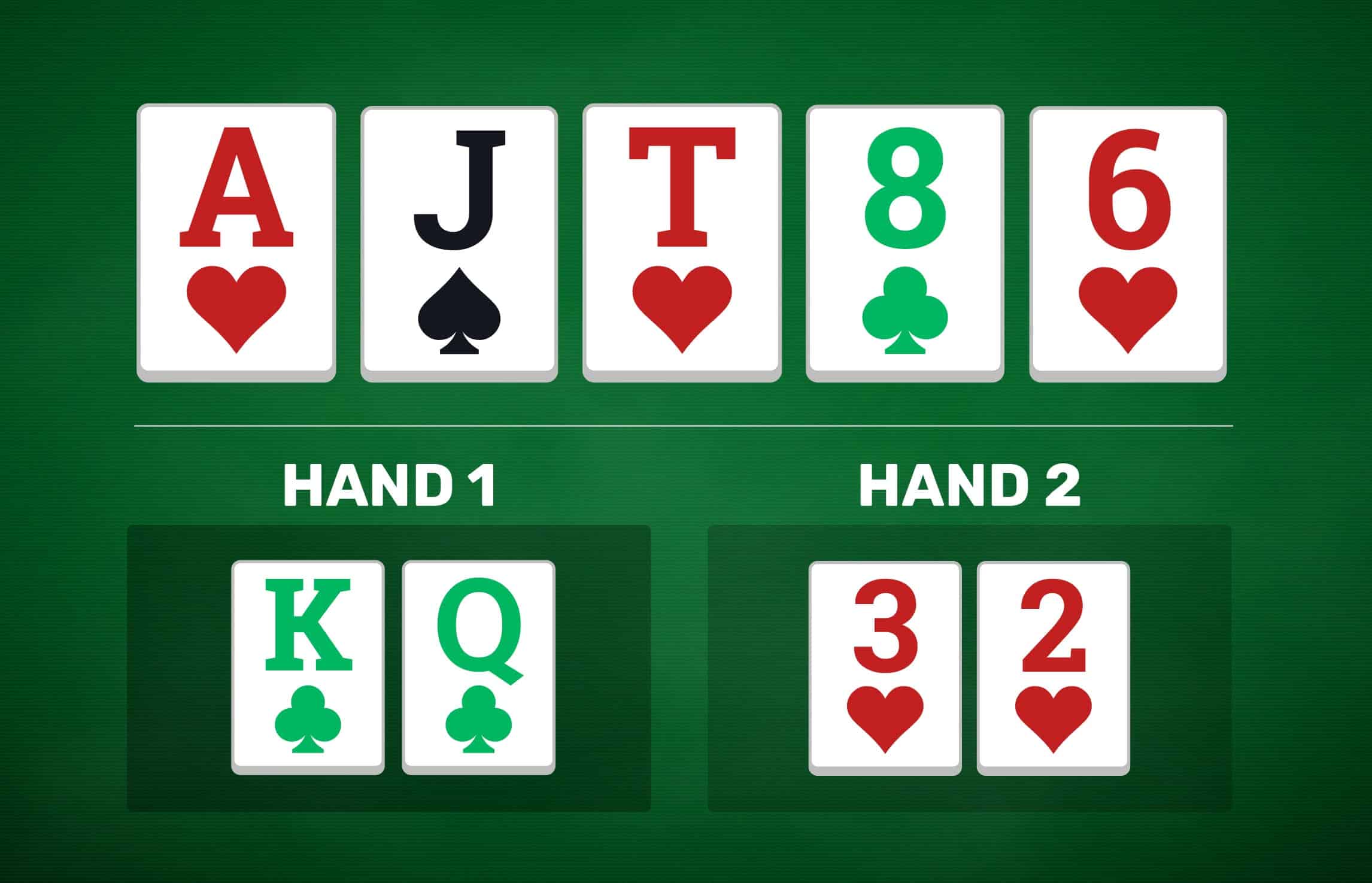
Hand 1 was in great shape on this flop, making a broadway: the highest possible straight. However, the river completed a flush for Hand 2. Thus Hand 2 is the winner.
Do you want some more practice at figuring out who has the winning hand? Here’s a quick quiz that sets up additional examples to the three given above.
You can also practice this critical skill of determining who won the hand by watching poker on television or streaming platforms, but ultimately the true test comes when you start to play the game yourself. Further, figuring out what your hand is, and what it might become as the board cards are dealt, has a significant impact on how you bet your hand.
The next step on your poker journey
The strategy and tactics of poker are addressed in countless YouTube videos such as those produced by Red Chip Poker, and our co-founder James “SplitSuit” Sweeney’s other YouTube channel: The Poker Bank. If you decide to take your poker journey to the next level, our CORE program picks up where this article leaves off.

